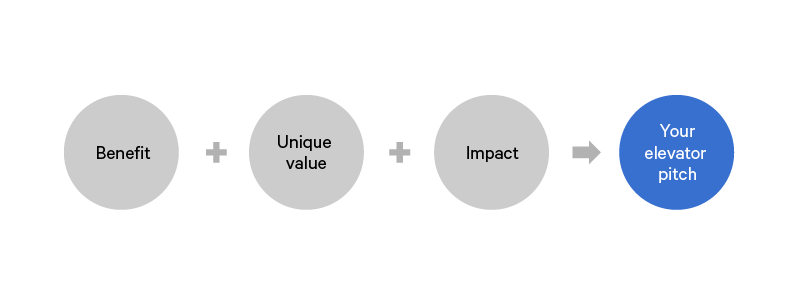Le secret d’un « elevator pitch » efficace

Articles suggérés
Sur des sujets similaires
Comme son nom l’indique, un « elevator pitch » fait référence à la brève conversation nous permettant de nous présenter à un contact en quelques secondes, le temps d’un voyage en ascenseur. Le défi? Réussir à exprimer en termes simples et concis qui on est, ce qu’on fait, et la valeur ajoutée qu’on offre à un client, un partenaire ou un investisseur potentiel. Tel qu’il l’a fait au récent déjeuner-conférence d’Innovacorp à Halifax, notre collègue Leo Artalejo, conteur en chef et conseiller principal chez NATIONAL, présente aujourd’hui les assises d’un elevator pitch réussi, c’est-à-dire le bénéfice pour le client, la singularité de l’offre, et le résultat attendu. (Le billet est en anglais.)
———
Named for the brevity required to deliver to a prospective customer between floors while riding in an elevator, your elevator pitch is an opportunity to articulate why you do what you do and why others should care in a concise and clear manner. It’s essential to your success because it requires being able to effectively communicate your company’s unique value differentiator, or compelling selling proposition or whatever fancy business term you prefer to use.
For the I-3 Technology Start-Up Competition, we had the opportunity to work with the ten sector and zone finalists to craft their company story as a one-minute elevator pitch for the 700 audience members in attendance at the Awards Ceremony in Halifax on Feb 3, 2016.
Many people confuse the notion of an elevator pitch with a sales pitch. While a sales pitch is a formal presentation to a qualified lead or potential customer, an elevator pitch is a narrative you can use with any audience. This is often the first step in determining whether or not your audience has any interest in your company’s product or service. Your challenge is to use accessible language in 60 seconds to get to the heart of what you want to tell potential buyers, partners, investors and clients.
Here are the three building blocks of your elevator pitch:

- Customer Benefit: the solution your company or product enables and the reason the customer wants what you’re selling
- Unique Value: the reason the customer might want to buy from you in particular
- Impact: how the world will be different as a result of your product or service
Your elevator pitch needs to contain these three parts in one or two sentences each. Be sure to use simple, easy-to-understand language, avoiding technical jargon and acronyms. To make this even easier, here’s the fill-in the blank model that we used for the I-3 finalists:

Use this model to get started, and feel free to modify as you need. I gave a talk on this elevator pitch model at Innovacorp’s Business over Breakfast recently and the archived video (below) is worth a watch.
At NATIONAL, we work with organizations of all sizes and sectors, in Canada and around the world to help make meaningful connections with the right people, at the right time, in the right way. The elevator pitch is a very powerful tool for doing just that.
——— Rédigé par Leo Artalejo, anciennement conteur en chef et conseiller principal, Cabinet de relations publiques NATIONAL.

